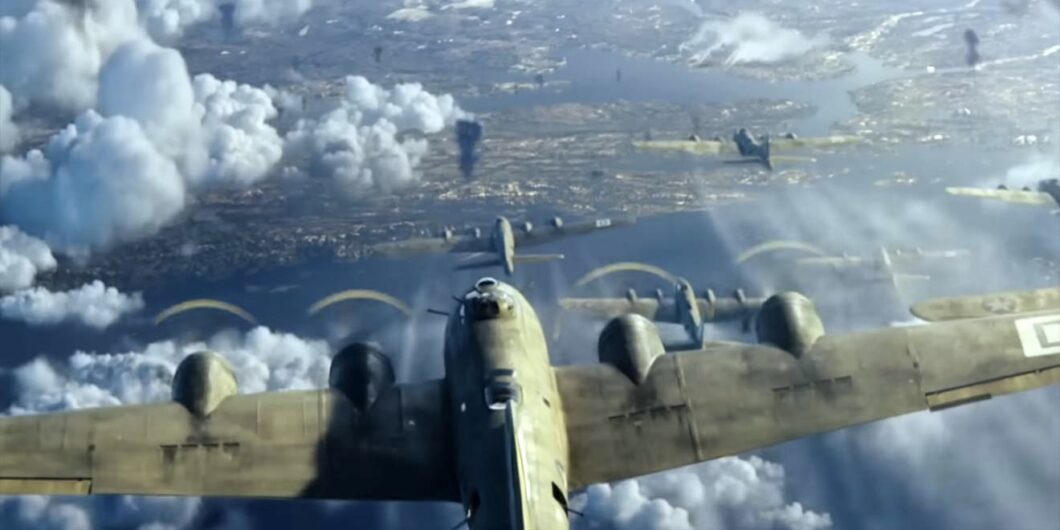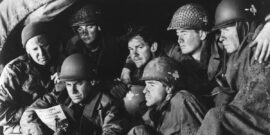The Preacher in Ecclesiastes says the end of a matter is better than the beginning. Not for Britain in World War II, however.
Flying the Unfriendly Skies
The best scenes in Masters of the Air, a nine-part series on Apple TV, arrive at 25,000 feet, as squadrons of B-17 Flying Fortresses cruise in formation to bomb Germany during World War II. Oxygen masks strapped on, the crews man their posts and brace for flak and Luftwaffe fighter planes. The ball turret gunner squeezes into his glass globe in the underbelly, the waist gunners swing their weapons to the ready, the navigator hunches over crinkling charts, the bombardier readies his Norden bombsight. On the flight deck, the pilot and co-pilot grimly watch as flak shells burst and pop. The gray-black traces are eerily beautiful, ephemeral flowers blossoming in a pale blue field.
Then the flak hits. On the ground, the lumbering B-17s appear impregnable. Sheathed in plated steel and powered by four engines, the aircraft bristle with heavy guns and weigh more than six tons when loaded with bombs. In the air, they are fat targets with fragile skin. The flak punches ragged holes in the fuselage, eviscerates engines, shreds wings. Swarming German Messerschmitts—“bogies”—further perforate the planes with machine gun fire. The pilots struggle to stay aloft, pressing toward the target even as B-17s around them flame out, break apart, or plummet to the earth. The waist gunners frantically swing their .50 caliber guns back and forth in open bays, firing at bogies, empty shells clattering to the floor. As the B-17 shudders and heaves, the navigator clings to his table, trying to stay upright to map the course and log the fate of his squadron’s other planes. All the while, the bombardier hunches over his sight, peering through it like a scientist with a microscope, awaiting the pilot’s order to drop. The gunfire and shrapnel incessantly wound and kill men without warning. That the crews are able to accomplish their duties is incredible; that they return to base alive and intact seems miraculous.
But many B-17s and their crews didn’t return. Masters of the Air unflinchingly portrays the real-life costs of strategic bombing missions in the European theater to US crews assigned to the 100th Bomb Group of the Eighth Air Force. According to the US Strategic Bombing Survey, 79,265 American airmen died in action in Europe (a comparable number of British airmen died as well). More than 18,000 US aircraft were shot down or damaged irreparably. The Eighth Air Force lost more than 26,000 men. In the series, these deadly statistics are dramatized by recreations of deadly bombing runs against Messerschmitt factories, submarine pens, ball-bearing plants, and the German capital of Berlin. In one episode, an already undermanned mission—17 aircraft—returns just one plane from the 100th Bomb Group. In the interrogation center, where staff officers collect intelligence from crews, the survivors slump in stunned silence, unable to answer basic queries about the missing aircraft. “No record,” they keep mumbling. Finally, one man is able to confirm seeing a plane go down. When asked if he saw chutes, he can’t take it anymore. “I just said, they blew up!” No one responds.
Living and working under those conditions, it’s no wonder that the 100th throws an alcohol-fueled bash when the first crew reaches the magic number of 25 missions. That achievement earns them a ticket home. Yet even as they celebrate with abandon, the men who must continue to fly can’t escape knowing that the odds of them making it to 25 missions are long.
The series, adapted from historian Donald L. Miller’s book Masters of the Air: America’s Bomber Boys Who Fought the Air War Against Nazi Germany (2006) and produced by Steven Spielberg, is centered around the endearing friendship and occasional rivalry of two real-life aviators, Gale “Buck” Cleven (Austin Butler), from Wyoming, and John “Bucky” Egan (Callum Turner), from Wisconsin. (A scene in the first episode explains how the men ended up with similar nicknames, but viewers may forgive themselves for the initial confusion.) Cleven is unflappable and laconic, and Butler delivers his lines in a throaty drawl. Egan runs on higher octane fuel. He’s only at ease in the cockpit. When he’s not flying, he’s restless and impatient, siphoning off his excess energy with booze and dancing. He frequently goads Cleven, who only once, and memorably, takes the bait. Both men joined the Army Air Corps before the US entered the war. As majors in the 100th Bomb Group, they arrive in southern England in the spring of 1943 to lead some of the first bombing missions flown by American crews.
Another central figure (also historical) is Major Robert “Rosie” Rosenthal (Nate Mann), whose calm demeanor masks extraordinary flying skills. Rosenthal flew 52 missions, a record for the 100th. Also prominent is navigator Harry Crosby (Anthony Boyle). Boyle ably conveys Crosby’s early mission jitters and the enormous stress he later experiences plotting D-Day aerial missions. Voiceovers from Crosby, delivered from an indeterminate time in the future, provide context and necessary historical facts. For example, he explains that in contrast to the Royal Air Force (RAF), the Army Air Corps executed its missions during daytime, in order to improve the chances of bombs hitting their targets. Daytime missions yielded a distinctive advantage to the Germans, especially while their air defenses were strong; thus the staggering losses of crews and aircraft.
Just as we are getting to know certain fliers as compelling characters, they disappear—killed in action. Their loss is apt and sobering, a necessary reminder that the real-life fliers endured the deaths of comrades again and again.
Was it worth it? Direct hits, even during daytime raids, were rare. By one estimate, only 2-3 percent of heavy bombs dropped during World War II directly hit their targets. The impossibility of precision bombing pushed the British to switch to nighttime raids targeting dense urban centers. According to this strategy, killing German civilians meant killing workers. Also, it was hoped, the terror and destruction brought by bombing would undermine German support for the Nazis. The first part of the strategy worked. Again, according to the US Strategic Bombing Survey, bombing took the lives of 300,000 German civilians, pulverized cities into “hollow walls and piles of rubble,” and damaged the German industrial base, the sum of all this becoming “the scars across the face of the enemy, the preface to the victory that followed.”
Bombing did not, however, measurably weaken support for the Nazis, as Bucky Egan finds out in a horrifying way. After being downed and captured, he’s marched, along with several other fliers, at night through a German town that’s just been bombed by the RAF. In a scene reminiscent of a Hieronymus Bosch painting, residents extinguish fires and retrieve the dead and wounded from smoking rubble. A mob turns on the American fliers, cursing them as Terrorflieger (terror fliers). The guards allow the civilians to savagely beat the prisoners to death; only Egan survives.
The series faithfully follows the chronology of the 100th Bomb Group from their arrival in England to the end of the war, though the story arc may frustrate viewers expecting to consistently follow a core set of characters. Just as we are getting to know certain fliers as compelling characters, they disappear—killed in action. Their loss is apt and sobering, a necessary reminder that the real-life fliers endured the deaths of comrades again and again. Each mission might be their last. In a poignant scene, Crosby packs the belongings of his friend and fellow navigator Joseph “Bubbles” Payne (Louis Greatorex), who has just been killed in action. He finds a letter Bubbles wrote to Crosby’s wife, but hadn’t yet posted, when Crosby was briefly presumed lost after his aircraft crash-landed. “I wish more than anything that it was him sitting here and not me,” Crosby reads. “And then no one would have to write this letter.” In another episode, Buck Cleven’s aircraft goes down during the second raid on the submarine pens at Bremen. During the post-mission debriefing, the returned crew ominously report that no chutes were seen. Cleven’s status, and that of his crew, remain unknown for some time, until they turn up in a prisoner-of-war (POW) camp.
Still, some storylines are clumsily handled. Early in the series, two fliers downed in Belgium are given a stark choice by the Resistance: turn themselves into the Germans for internment in a POW camp or entrust the Resistance to deliver them to a neutral country for return to England. “If you choose to escape, you will be treated as a spy if captured and likely you will be executed.” Both men opt to go with the Resistance. We closely follow their harrowing journey from Belgium to Paris, only to abruptly leave them there for several episodes before their fate is hurriedly recounted in a voiceover. The famed Tuskegee Airmen (332nd Fighter Group) enter the series late, flying missions over southern France. The aerial combat scenes are stunning, but this plot addition, though true to history, feels tacked on, and the creators seem in a rush to bring downed black pilots into the same POW camp holding Egan and other men from the 100th Bomb Group. By the series’ end, a good portion of the cast is in German custody. The scenes inside the camps, which comprise lengthy portions of the later episodes, are sustained mostly by Butler’s and Turner’s fine acting, which vividly shows two men torn between meekly submitting to captivity and desperately wanting to escape.
Nate Mann delivers the finest performance of the large cast. Outwardly stoic and soft-spoken as Robert “Rosie” Rosenthal, Mann is sensitive and empathetic, his bravery tempered by modesty. His subtle gestures—a twitch of the jaw, a trace of a smile, a caring gaze—give us a man who has somehow found, deep within himself, the ballast needed to stay steady, though it’s difficult to say at what cost to himself. Late in the war, Rosie, who is Jewish, is rescued by the Soviet Army after his plane goes down following a raid on Berlin. During his return journey, he walks through the emptied barracks of a death camp and sees bodies stacked like firewood. Back in England, Rosie listens thoughtfully as Crosby confesses his remorse at the loss of life Allied bombing has caused. “The things these people are capable of,” Rosie answers quietly, without sharing what he has seen. “They got it coming. Trust me. They got it coming.”
We should neither cheer—nor condemn—these devastating lines. Instead, take them as the heartfelt response of a man whose actions killed civilians in the name of ending a war that had already killed tens of millions of people. And take them as the genuine expression of a man who understood that to save humanity, he had to sacrifice some of his own.



